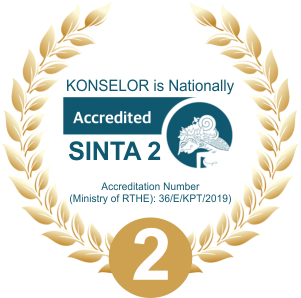The effectiveness of religion-based self-management training to reduce internet addiction in madrasah aliyah students
 ), Muafatin Muafatin(2),
), Muafatin Muafatin(2), (1) Universitas Islam Negeri Antasari Banjarmasin
(2) Madrasah Aliyah Negeri Kapuas,
 Corresponding Author
Corresponding Author
Copyright (c) 2023 hidayat ma'ruf
DOI : https://doi.org/10.24036/02022114116777-0-00
Full Text:
 Language : en
Language : en
Abstract
Like a double-edged sword, the internet has many benefits but can also have negative impacts. The use of the internet in education can help improve student academic achievement, but its excessive use can make students addicted to the internet. Internet addiction can reduce academic achievement, reduce psycho-social abilities, and cause psycho-emotional problems. It is not easy and takes time to reduce internet addiction, because it has to wait for the individual to realize that he is experiencing a problematic behavior and wait for his will to change. Training self-management with a religious approach is seen as effective in reducing internet addiction for students who have religious lives. This study showed a significant decrease in internet addiction by 0.458 in students who took part in religious-based self-management training. Although the effectiveness is still low (N-Gain = 0.2) or N-Gain < 0.3, religion-based self-management training can raise awareness and willingness to change behavior and can significantly reduce internet addiction in all trainees.
References
Afdal, A., Alizamar, A., Ifdil, I., Ardi, Z., Sukmawati, I., Zikra, Z., Ilyas, A., Fikri, M., Syahputra, Y., & Hariyani, H. (2019). An Analysis of Phubbing Behaviour: Preliminary research from counseling perspective. 295(ICETeP 2018), 270–273. https://doi.org/10.2991/icetep-18.2019.65
Akdeniz, B., Gunduz, M., Calli, S., Demirdogen, E., & Yavuz, M. (2020). Parental attachment and the theory of mind abilities as predictors of internet addiction in Turkish adolescents. Psychiatry and Clinical Psychopharmacology, 30(3), 1. https://doi.org/10.5455/pcp.20200427054916
Alexy EM, Burgess AW, P. R. (2009). Pornography use as a risk marker for an aggressive pattern of behavior among sexually reactive children and adolescent. J Am Psychiatr Nurses Assoc., 14(6)(Jan), 442–453. https://doi.org/10.1177/1078390308327137. PMID: 21665787.
Ali, J., Bemby, B., & Sentosa, I. (2013). The Intelligence, Emotional, Spiritual Quotients and Quality of Managers. Global Journal of Management and Business Research, 13(3), 1–11.
Ambad SNA, Kalimin KM, Y. K. Y. (2017). The Effect Of Internet Addiction On Students’ Emotional And Academic Performance. 6(1), 86–98. https://e-ajuitmct.uitm.edu.my/v3/index.php/articles/volume-9-issue-1-2020
Carey Jewitt, W. C. and C. H.-G. (2011). the Use of Learning Platforms To Organize Learning. 1–14. https://doi.org/10.1080/17439884.2011.621955
Duchesne, S., Vitaro, F., Larose, S., & Tremblay, R. E. (2008). Trajectories of Anxiety During Elementary-school Years and the Prediction of High School Noncompletion. Journal of Youth and Adolescence, 37(9), 1134–1146. https://doi.org/10.1007/s10964-007-9224-0
Hommel, B., & Colzato, L. S. (2010). Religion as a Control Guide: On the Impact of Religion on Cognition. Zygon, 45(3), 596–604. https://doi.org/10.1111/j.1467-9744.2010.01115.x
Jackson, T. (2005). Motivating Sustainable Consumption. A Review of Evidence on Consumer Behaviour and Behavioural Change In A Report to the Sustainable Development Research Network as Part of the ESRC Sustainable Technologies Programme Centre for Environmental Strategy University of Surrey Guildford, 15(January), 1027–1051. https://doi.org/10.1260/0958305043026573
John. OP, & Srivastava, S. (1999). The Big-Five Trait Taxonomy: History, Measurement, and Theoretical Perspectives. In Department of Psychology University of California. https://doi.org/10.1109/ICARM.2016.7606898
Khan, M. J., Altaf, S., & Kausar, H. (2013). Effect of perceived academic stress on students’ performance. FWU Journal of Social Sciences, 7(2), 146–151.
Koenig, H. G. (2009). Research on religion, spirituality, and mental health: A review. Canadian Journal of Psychiatry, 54(5), 283–291. https://doi.org/10.1177/070674370905400502
Lally, P., Jaarsveld, C. H. M. Van, Potts, H. W. W., & Jane Wardle. (2010). How are habits formed: Modelling habit formation in the real world. European Journal of Social Psychology Eur., 40(June 2009), 998–1009. https://doi.org/10.1002/ejsp.674
Ma’ruf, H. (2020). Efektivitas Pelatihan Kecerdasan Adversitas Berbasis Islam Untuk Meningkatkan Daya Juang Mahasiswa Baru UIN Antasari Banjarmasin Pendahuluan. SMaRT Studi Masyarat, Religi, Dan Tradisi, 6(1), 17–31. https://doi.org/10.18784/smart.v6i1.862
Meltzer, D. E. (2002). The relationship between mathematics preparation and conceptual learning gains in physics: A possible “hidden variable” in diagnostic pretest scores. American Journal of Physics, 70(12), 1259–1268. https://doi.org/10.1119/1.1514215
Menon, Shanker, Narayanan, Lakshmi, Kahwaji, & Taha, A. (2018). Internet Addiction: A Research Study of College Students in India. Journal of Economics and Business, 1(1), 100–106. https://doi.org/10.31014/aior.1992.01.01.9
Mesch, G. S. (2009). Social bonds and Internet pornographic exposure among adolescents. Journal of Adolescence, 32(3), 601–618. https://doi.org/10.1016/j.adolescence.2008.06.004
Moldasheva, G., & Mahmood, M. (2014). Personality, learning strategies, and academic performance: Evidence from post-Soviet Kazakhstan. Education and Training, 56(4), 343–359. https://doi.org/10.1108/ET-10-2012-0101
Noftle, E. E., & Robins, R. W. (2007). Personality Predictors of Academic Outcomes: Big Five Correlates of GPA and SAT Scores. Journal of Personality and Social Psychology, 93(1), 116–130. https://doi.org/10.1037/0022-3514.93.1.116
Prochaska, J. O., & Velicer, W. F. (1997). The transtheoretical model of health behavior change. American Journal of Health Promotion, 12(1), 38–48. https://doi.org/10.4278/0890-1171-12.1.38
Rote, S., Hill, T. D., & Ellison, C. G. (2013). Religious attendance and loneliness in later life. Gerontologist, 53(1), 39–50. https://doi.org/10.1093/geront/gns063
Savolainen, I., Oksanen, A., Kaakinen, M., Sirola, A., & Paek, H. J. (2020). The role of perceived loneliness in youth addictive behaviors: Cross-national survey study. JMIR Mental Health, 7(1). https://doi.org/10.2196/14035
Spada, M. M. (2014). An overview of problematic internet use. Addictive Behaviors., 39(1)(Jan), 3–6. https://doi.org/doi: 10.1016/j.addbeh.2013.09.007
Walz, G. R., Bleuer, J. C., Caldwell, C. D., & Cunningham Caldwell, T. J. (2010). Internet Addiction and Students: Implications for School Counselors. American Counseling Association, 1–10.
Weinstein, A., & Lejoyeux, M. (2010). Internet addiction or excessive internet use. American Journal of Drug and Alcohol Abuse, 36(5), 277–283. https://doi.org/10.3109/00952990.2010.491880
Young, K. S. (1998). Internet addiction: The emergence of a new clinical disorder. Cyberpsychology and Behavior, 1(3), 237–244. https://doi.org/10.1089/cpb.1998.1.237
Young, K. S. (2007). Cognitive behavior therapy with internet addicts: Treatment outcomes and implications. Cyberpsychology and Behavior, 10(5), 671–679. https://doi.org/10.1089/cpb.2007.9971
Young, K. S., & Abreu, C. N. de. (2011). Internet addiction: a handbook and guide to evaluation and treatment. In John Wiley & Sons, Inc.
 Article Metrics
Article Metrics
 Abstract Views : 341 times
Abstract Views : 341 times
 PDF Downloaded : 98 times
PDF Downloaded : 98 times
Refbacks
- There are currently no refbacks.
Copyright (c) 2023 hidayat ma'ruf

This work is licensed under a Creative Commons Attribution 4.0 International License.







